|
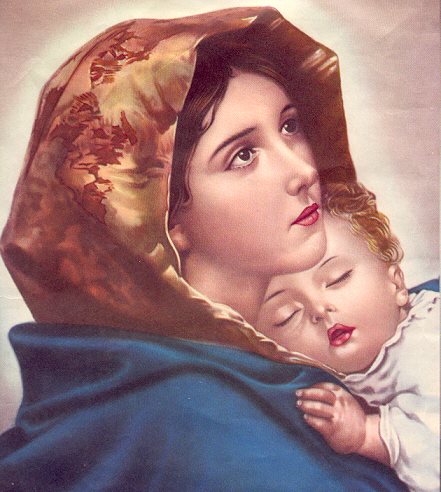
Organizations
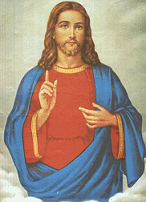
Life of Jesus
Bible
|
Home
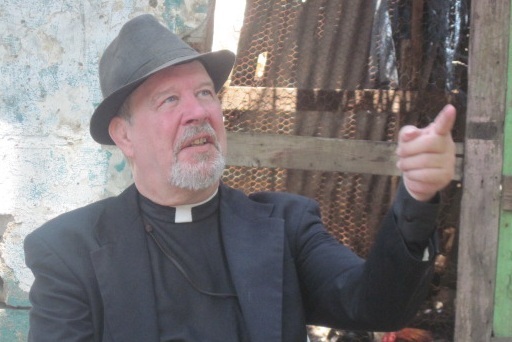
Did the Syriac Orthodox Build Churches in China?
by Father Dale A. Johnson (Barhanna)
The Silk Road is understood to be a network of routes between East and West (Europe and China). It is the largest human interaction across space and time, across ecological and civilizational boundaries, in the history of the world. It is a story of human courage to venture beyond the known boundaries into the unknown. The Syriac Orthodox church was at one end of this ancient global network. Antioch connected the Silk Road to the Mediterranian Sea. It is no surprise to discover that the Syriac Orthodox church not only had contact with China but made major contributions to China.
In 643 A.D. a mission was sent from the Patriarch of Antioch to the royal court of China in Xian. This mission was sent by His Eminence John II, Patriarch of the Syriac Orthodox church (641-648). This mission is recorded in the Chinese Book of Tang. The Tang Dynasty had opened it doors to the world. When the mission arrived it was the beginning of the golden age of China fueled by the cosmopolitan ideas, technologies, and goods flowing back and forth on the Silk Roads. The west craved Silk and tea. China lusted for horses from central Asia to strengthen their army and Turkish fashions to please their women.
The Syriac Orthodox mission followed in the footsteps of the Assyrian Church of the East who sent a Bishop named Alopen a few years earlier in 635 A.D. The Assyrian Church of the East had already established a beachhead for Oriental Christianity in the capital of China. There were perhaps as many as 30,000 Christians of Syriac origin living in Xian. This population did not just consist of Nestorians (a misnomer for the Assyrian Church of the East) but also Syriac Orthodox and Melchites. No doubt there were Armenians and perhaps a few Coptic too but I have not found evidence for their presence yet.
There seems to be no official missions sent from Antioch after 643 although there may have been one in 788 AD.
Nevertheless, the Syriac Orthodox continued to make their presence known in China. Empress Wu zeitong, the first and only female Emperor of China imported stone masons from Tur Abdin to help in the construction of massive building projects during her era (690-705). Records indicate an architect my the name of Abraham from the Tur Abdin region. He was the project leader in many of the most important projects funded by Empress Wu. It is interesting to note that Empress Wu was a Buddhist and many of her projects celebrated Buddhist ideals yet she used Christians from Tur Abdin. I often think about their lives here in China. It must have been a shock for them to live in such a strange and alien world. The church must have been a source of refuge for them.
There are also other hints that there were Syriac Orthodox churches in China. The Xian-Fu stone in Xian is dated 781 AD. It was written in both Chinese and Syriac. There are over 70 names written in Syriac listing the names of mostly priests and their locations in China. While this 10 foot tall stone with over 2000 Chinese characters tells the story of the Assyrian Church of the East in China it must have included Syriac Orthodox communities as well. We know this because the Chinese did not distinguish between various denominations of Christians. They saw them all as one group. This occurred not only during the Tang Dynasty when many Christian missions arrived (the Melchites sent five missions) but also in later periods when the Chinese saw no distinction in their records.
between the Roman Catholics and Protestants during the Ming Dynasty in the 18th and 19th centuries.
Also, in 1291 the Minister of Christianity was a Syriac Orthodox layman named Issa (E-ssa), from Antioch. He served Kublai Khan (one of the few Mongol Emperors of China) who was a Buddhist and whose mother was a “Nestorian.” He must have been a good choice because he was Syriac Orthodox. He was not “Nestorian” and would not directly connect Kublai Khan with a major religion of the state and yet he would have also been acceptable with the Assyrian Church of the East. Also this minister later became a Minister of Civil Affairs in China. This would have been like a Secretary of State and a very high position. Furthermore, the Chinese did not distinguish between denominations of Christians and would not have been a concern because he was Syriac Orthodox.
So this leads to a natural question: where were the Syriac Orthodox churches in China? Did they exist and what archaeological evidence is remains if any?
I began this search 24 years ago when I went to Xian to study the Xian-Fu stone. Three years ago I returned after several more trips to live for several months at a time in order to investigate the questions mentioned above. Two years ago I stumbled upon what I believe to be the first evidence of a Syriac Orthodox church in China.
Evidence of a Tang Era Christian Ruin in Southwest China
Evidence of a Tang Era Christian Ruin in Southwest China
 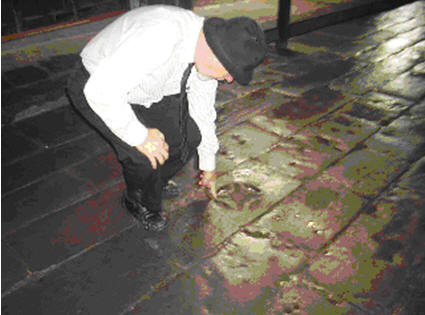
During the Tang Dynasty there were Christian Churches throughout China. Where were they located? We have brief hints from a stone monument erected in 781 C.E. near the capital of Xian dedicated to Christians called Jing Jiao of Syrian origin. It says "The religion_ spread throughout the ten provinces . . . monasteries abound in hundred cities.” Unfortunately very little evidence has been found. One hint points to the
southwest region of China in the Sichuan province, part of the south route of the Silk Road
Ciqikou is a Chinese village that dates back 3000 years. It was the capital of the ancient Ba Kingdom (316 BCE) that was overthrown by the Qin Dynasty that ruled during the time of Christ. Originally called Longyinzhen, Ciqikou (simplified Chinese: 龙隐镇;
traditional Chinese:
龍隱鎮;
pinyin: Lóngyǐnzhèn)
was also known as Little Chongqing. It was given it’s present name by Emperor Zhenzong of the Song Dynasty (r. 998-1004). It gained prominence during the Ming Dynasty as a commercial port of porcelain shipping by land and water.
The Jing Jiao Christian stone erected in 781 AD in Xian may reference this location during the Tang Dynasty (618-907 C.E.) on the monument. On the left side, second row, at the very top is a priest named Bakos. He is from Ch’ung-ching.
According to the Monument, there were prior to A.D. 781 Christians called Jing Jiao of Syrian origin in at least (8) towns in China, (5) of which were situated in the west. According to Fred Aphrem and other scholars, there may even have been a church in every province based on what Rubruck wrote five centuries later to the effect that in his time there were Christians of Middle Eastern origin in at least (15) towns in China.(1)
We know that in Loyang a Jing Jiao monastery was erected in the Shau-hsien quarter, and there were also monasteries in Tuan-huang, Ling-wu and in Szechuan.
During the reign of Empress Wu, in 690 she proclaimed herself the founder of a new dynasty -Chou - and wished to be memorialized. Accordingly her half brother, Wu San-Ssu, proposed to erect a gigantic column in her honor, to be located outside the Tuan gate of the Imperial city. It was to be an octagonal column with a height of 105 feet built in a base with carved unicorns. On the pinnacle of the column was to be a dragon embracing a large orb representing the rising sun. The enormous task of financing and erecting the imposing column was entrusted to a Jing Jiao Christian man named Abraham from the Persian Empire, district of Tur Abdin. The project took only eight months to complete.
Although Empress Wu was a Buddhist Abraham's act of homage must have assured the Empress of the loyalty of the Jing Jiao congregation and thus averted the Buddhist attempt to destroy the Jing Jiao community in Luyong and to uproot the young church from Chinese soil. The inscription on Abraham’s tombstone stated that he brought the holy religion to the barbarian tribes who had since lived in peace and concord. He died on the first day of the fourth month in the first year of Chun Yun (710) at his private residence in Loyang, aged 95.
In 713 the Emperor Xuan Tsong (712-757) ordered the Prince of Ning Kuo and four other princes to go to the Jing Jiao monastery to build and set up the altars again. Stone masons were needed and no doubt many were recruited from the Jing Jiao community in Xian and many were imported from the Persian west region of Tur Abdin. Certainly Christian iconography was inscribed in stone.
Of Bishop Gabriel (Chih-lieh) we obtain valuable information from Chinese sources. It is significant to note that Gabriel came to China by sea. Toward the end of the 7th century, Canton had become the chief seaport for foreign trade. Bishop Gabriel arrived in. Canton in 713 or earlier. He worked among Persian merchants and craftsmen and acquired a knowledge of Chinese. Gabriel made the acquaintance of the Inspector of merchant shipping, Chou Ching-li. With the encouragement and help of Chou, he began to "carve quaint things and make wonderful objects." It aroused, however, the antagonism of Liu Tse, the Prefect of the Province. He submitted a petition to the Emperor. "Ching-Ii is seeking to beguile your sage understanding, to shake and subvert your lofty mind. Will your Majesty trust and allow it? This would be to spread decadence in the whole Empire!" The Emperor was probably more interested in the stone mason skills of the people under Bishop Gabriel and of Abbot Abraham who seemed to have created a positive atmosphere in Xian (Chang-an.)
According to the Tse Fu Yuan Kuei, the second mission of Bishop Gabriel took place in October 732 when the King of Persia sent the chief P'an-na-mi with Bishop Gabriel on an embassy to Chang-an. The Emperor was pleased and gave Gabriel a purple kashaya and fifty pieces of silk.
In 744 Bishop George (Chi-ho) a third mission was sent to the Far East. Bishop George was permitted to celebrate the Eucharist in the Palace of the Emperor's elder brother. In October 745 an Imperial decree stated that since the administrative center of Syriac Christianity was in Da Qin outside of Xian. From here churches and monasteries of the Jing Jiao Syriac Christians spread throughout China and no doubt this included Longyinzhen which was to become Ciqikou. The following evidence suggests to me that not all churches were of the Assyrian Church of the East. The one in Ciqikou seems to be a Syriac Orthodox Church according to the iconography of the crosses discovered.
Iconographic Analysis of the Ciqikou Cross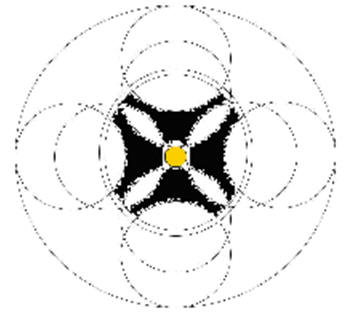
The icon of the cross of Syriac Orthodox origin has a distinctive design. It consists of a cross within a circle touching eight points. Two points on each end of the four ends of the cross touch the inner arch of the circle. Each arm of the cross is narrower near the middle than at the ends. The center of the cross draws to a circle at the center.
The cross is created from 12 circles of three sets of four circles. The one in Ciqikou, China, and Aleppo, Syria, follow a perfect quadratic equation. This cross is often mistaken for a Maltese Cross of the 13th c.
Comparative Evidence
The cross identified by the author in Ciqikou on October 1, 2011 is identical to crosses found in Aleppo Syria (6th c.), Tur Abdin, Turkey (8th-9th c.), Iran (? C.), and in the Uigher autonomous region of Northwest China (14th c.). These crosses are scattered along the Silk Road from Syria to China. These crosses date from the 6-14th centuries.
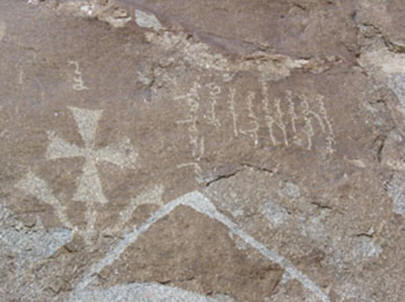
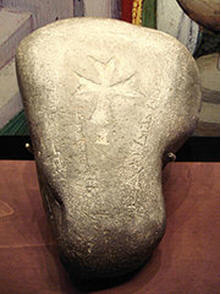
9th c. Cross with inscription, Tangtse,
dated 825 C.E. (2)
Kyrgyzstan, Issyk Kul, dated 1312.(3)
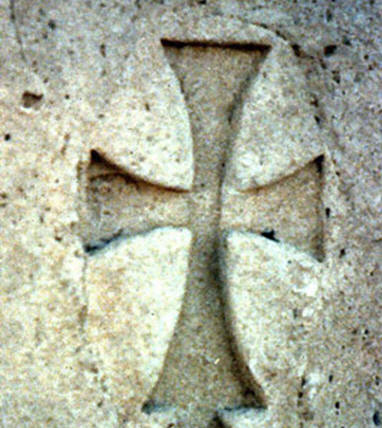
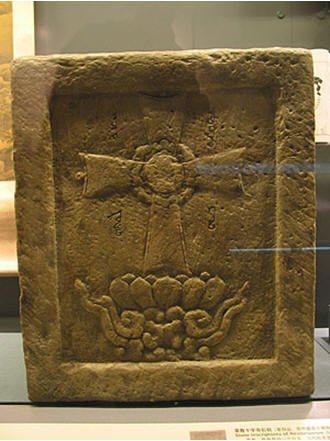
Hakaari, Turkey, undated Assyrian Cross (4)
14th Century, Yuan Dynasty, China (5)
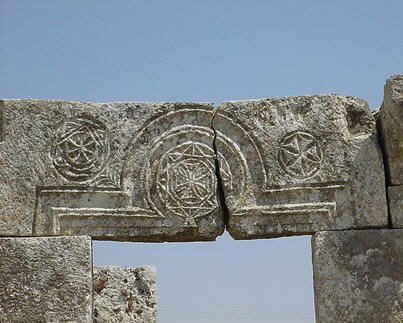
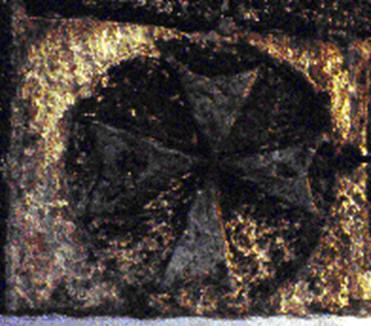
Aleppo Syria (6-7th c.)
(6)
Mor Gabriel Monastery, Midyat, Turkey (9th c.) (7)
Connection to the Xian-Fu Cross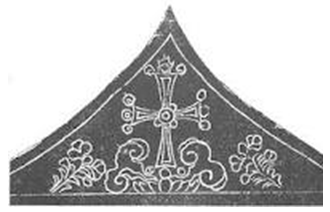
While not identical, the cross known as the Nestorian Cross in Xian is in the same class as the Ciqikou Cross. At the top of the Nestorian stele erected in 781C.E. is a cross seated upon a lotus flower and framed by clouds. Each arm of the cross is wider at the end and narrower toward the center. The sides of the cross are formed from arches of larger circles. On the end of each arm are three small circles constituting 12 circles.
At the nexus points of the arms near the center are four small circles. Each are is equidistant. Although stylistically this cross differs from the Ciqikou Cross it is fundamentally the same.
The equidistant cross is of Eastern Origin. The Church of Constantinople was essentially Asian and Eastern. When the Emperor Justinian erected the church of Santa Sophia at Constantinople, with the aid of the architects Artemius of Tralles, and Isidore of Miletus <http://www.newadvent.org/cathen/10303c.htm>, a new model for all churches was subsequently built throughout the Byzantine Empire <http://www.newadvent.org/cathen/03096a.htm> and further East. The Greek cross inscribed in a square thus became the typical form. This type of cross followed the Silk Road overland to China.
Collaborating Evidence
The Ciqikou cross was noticed on the main street of Ciqikou. This was not the original location of the cross icon. It was among a mix of stone from different quarries and several eras. Also, this stone bore evidence having been in vertical position for many years previously. The degradation of the stone showed a watermark where water created a grove in one of the corners. In a vertical position water would have worn this groove.
In a survey of the nearby area to determine from where this stone originated within a radius of one hundred yards there were many buildings that possessed a mix of stones from many eras. There was red sandstone of the Qin era, slate flagstone of the Sui and Tang era, and similar flagstone but of smaller sizes from Tang and later periods.
Pilgrim Cross
Directly to the east of the Ciqikou cross was another cross on the same street was another cross although far less aesthetic and more commonly seen as the type carved by pilgrims and travelers.
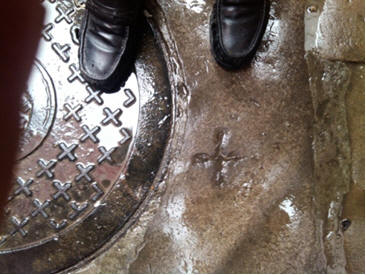
Pilgrim cross embedded in stone on Ciqikou street
Stone Capital
Civilizations can be identified by their architecture. In particular decorated columns supporting structure. Whether it is the Ionian or Corinthian capitals of Greece or the seven layer cross bream capitals of the Tang Dynasty.
Two hundred yards further north on the Ciqikou street where the cross is embedded in the street is a stone capital of Syrian design. Today it is used to support weary people at the entrance to a shop.
The intrepid explorer Gertrude Bell documented the stone ruins of Turkey and Iraq in 1907 on one of her several expeditions to the Middle East. She was particularly interested in the stone architecture on the once vast Persian civilization that stretched from Antioch to Xian. In the course of her work she made hundreds of photographs of the distinctive stone capitals of Syrian design in the region of Tur Abdin. I followed in her footsteps in the 1990’s and visited the many stone ruins she documented.(9)
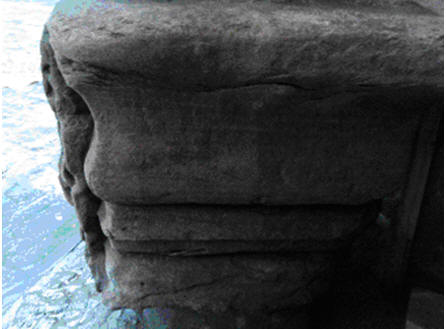
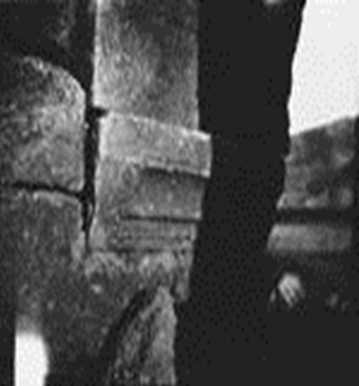
Triple curve Syrian capital , Ciqikou
G. Bell,
G_257 - (May / June 1907) Turkey
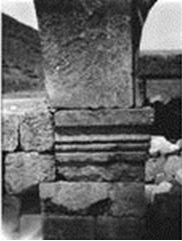
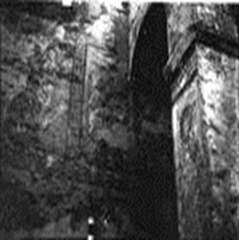
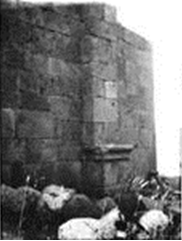
Examples of triple curve capitals: G. Bell photos g-243, I-177, and I-176
Southeast Turkey
How do we know this Syriac Orthodox church became a ruin in the 9th century
There is not enough evidence yet to definitively determine the terminus ad quem of the Christian building in Ciqikou. Non-Christian sources point to the 9th century demise of Christianity from the records of the Song Dynasty. We are told that both Christian and Buddhist institutions were condemned and forced to be abandoned in the 9th century in the year. 845 AD. It appears that the Christian community did not return but a Buddhist community did return in celebration and worship of Guan Yin in a later century.
Also the report of an envoy sent to China by the Assyrian Patriarch in 982 C.E. reported, "Christianity is extinct in China; the native Christians have perished in one way or another; the church which they had has been destroyed and there is only one Christian left in the land." This is no way is a comprehensive report but it does hint at the decline of a Syriac presence and influence in China.
What maybe the strongest evidence for a 9th century Christian church is the discovery of a stone base for a free standing cross.
Base for a Stone Cross
On a side street in Ciqikou, Chongqing, China is a round granite stone sitting in front of a curio shop. The owner has placed fish in a socket depression on the top where the base of a standing stone cross once stood. The designs on the side includes crosses within a Bodi leaf bordered by more Bodi leaves. The design is clearly Persian belonging to the style of leaf crosses.
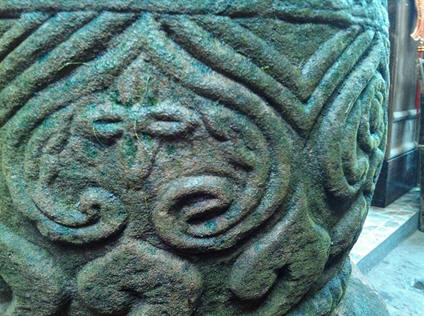
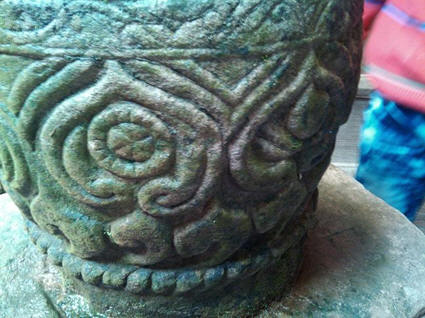
Crosses within Bodi (Ficus Religiosa) leafves of Persian Design
(http://nasrani.net/2008/02/29/analogical-review-on-st-thomas-cross-the-symbol-of-nasranis)
(11)
Leaf Crosses of Persia:
These crosses are also sometimes called Leaved Crosses or Persian crosses as they symbolize at the bottom a set of leaves. The leaves usually flow upwards either side of the base of the cross symbolizing the cross as the tree of life. This symbolism is not found in Latin or even in Byzantine art.
Examples of this type cross are found in India where Persian Christianity found its way to the subcontinent in the first millennium. Crosses with a Bodhi leaf (heart shape or spade designs) are identified as Persian crosses.
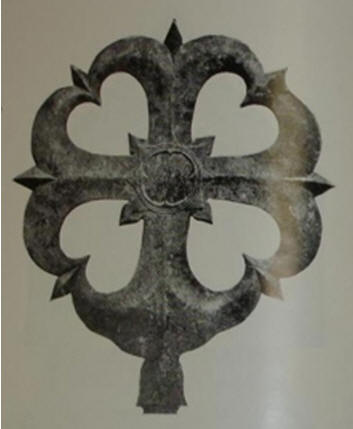
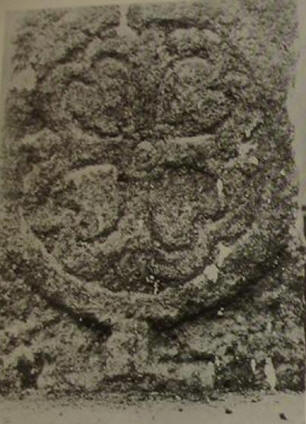
Kottakkavu ( Parur) Crosses
The Saint Thomas Kottakkavu Church at North Paravur under the diocese of Ernakulam-Ankamaly of the Syro Malabar Church has an ancient Persian Cross.(see above)
This cross is engraved on granite stone believed to be done by Mar Sabore and Mar Prothe about 880 AD . This is now preserved in the chapel in front of the church. This confirmed the dating of the Ciqikou crosses as also 9th century. (12)
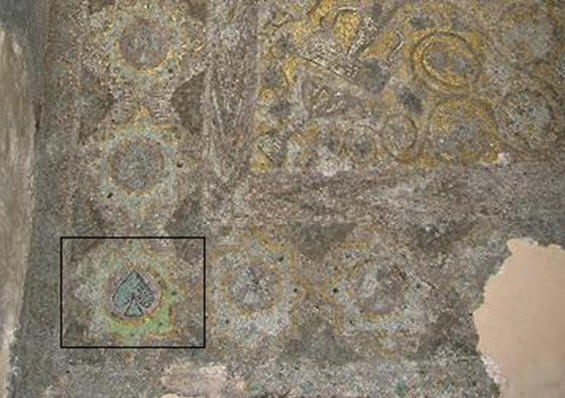
For several years I
stood three times a week under the ceiling of Mor Gabriel Monastery
(present day southeast Turkey). Above me was a stunning mosaic
containing gold, silver, turquoise, obsidian, and other precious
metals and stones. The mosaic is attributed to Justinian whose workers
completed the work in the early fifth century. At the time the
monastery was on the border of the Byzantine and Persian empires. Over
the centuries the monastery was raided by Persian armies. Much of the
gold was taken from the ceiling which was estimated to contain 18
kilos of the precious metal. Still, much of the gold remains. Framing
a pattern of grape leaves and a central cross was a border of “spade”
figures. I have come to interpret these as fig leaves, the same fig
leaves I see in the pillar base in China where a Syriac Orthodox
church once stood.
Socket cylinder
system
The stone unit
found in Ciqikou is part of a socket cylinder system. This artifact is
the first evidence of this system used by Christians of Persian origin
in China.
“The base with a
socket, the monolithic square and slightly tapering shaft with
cylindrical terminals, the horizontal piece forming the arms with a
double (hole) socket in the middle, and the capital with a cylindrical
bottom end are the four members of the open-air cross. They are so
well chiseled and proportionate that when put together the socket and
cylinder arrangement enables the cross to stand by itself.” (13)
Ficus Religiosa
The fig is first
mentioned by Chinese writers in the eighth century, and therefore it
is generally thought figs reached China no earlier than the Tang
period (618-907). Hia-tscheng-Shi in his work on Chinese trade,
Yu-yang-tsa-tsu, speaks of tin-tin; tin is 'fig' in Arabic, from Fo-tin
(Palestine). He mentions that this fruit was produced without
blossoms, which is the appearance figs give. The first verifiable
report of fig culture in China was that of the celebrated writer
Le-Shi-tschen who described figs growing in Chinese gardens.
The leaves of the
Bodhi or fig (peepul) tree have a beautiful heart or spade shape- they
taper to a needle point. When the leaves first appear their color is
red-pinkish but then turn deep green and grow to about 12 to 18 cm
long. They are attached to a long flexible stalk which makes them
rustle, flutter and dance in the slightest breeze.
Syriac Christians
follow a marriage custom practiced by Hindus of Kerala who perform
Nischaya Thamboolam(engagement) before marriage.The groom knots a
golden Thali (in the shape of a Peepel tree leaf[sacred fig] )
attached to either a gold chain or a yellow thread around the brides
neck .
From the
comparative evidence we estimate the base for the stone cross was
carved during the latter half of the Tang Dynasty. The corresponds to
our estimate that a Jing Jiao Church was present in what became the
Ciqikou area in the 9th century and perhaps slightly
earlier.
Syncretism
The Jing Jiao
Christians gravitated to the use of fig leaves in their religious
designs as an act of syncretism with Buddhist imagery. Siddartha sat
under the Bodi (ficus religiosa) tree and received enlightenment.
Christians who came to China at least by the 7th century
had at least thirty references to the fig in their sacred texts.
Christians found common ground with Buddhists in the use of the Bodhi
(fig) leaf imagery.
On the side street
of a side street I found another cross of the same design as the cross
found on the main street. It is terribly worn and damaged from
recently construction. It suggests that the stone artifacts of the
church need to be preserved.
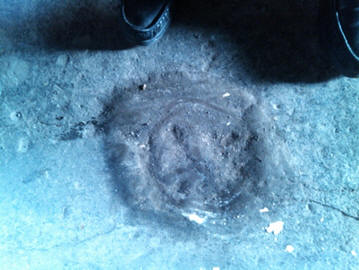
Notes:
Extensive
notes can be found in the book
Jing
Jiao: the Luminous Religion of China available through Amazon.com
and other online stores. Also, some of the material will be issued in
a forthcoming book by Father Johnson titled: Searching for Jesus
on the Silk Road.
|